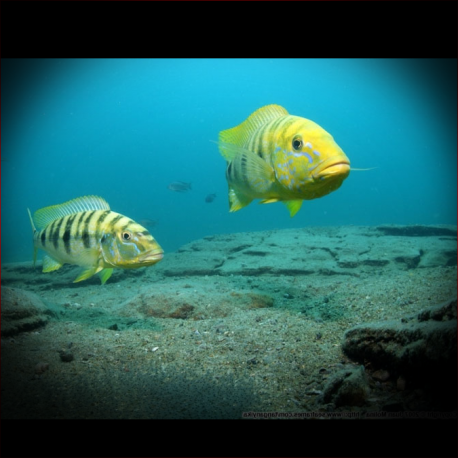More info
Datasheet
| Minimum Tank Size | 10000 litres / 2641.72 US gallons |
| Maximum Size | 55.0cm / 21.65inches |
| Temperature | 24°C / 75.20°F - 28°C / 82.40°F |
| Hardness | 10.03dgH / 179ppm - 25.04dgH / 447ppm |
| pH | 7.5-9.0 |
General Description
The Emperor Cichlid, scientifically known as Boulengerochromis Microlepis, is the sole member of its genus and holds the title of the largest African cichlid species. Endemic to Lake Tanganyika, this prized food fish boasts an elongated and streamlined body shape, equipped with a large, lunate caudal fin that aids in providing power and speed. Although predominantly piscivorous as adults, young Emperor Cichlids are omnivorous, transitioning to a piscivorous diet as they mature. Typically unsuitable for home aquariums except under extreme conditions, juvenile specimens have been readily available in the trade since the mid-2000s.
Aquarium Setup
For housing an Emperor Cichlid, a tank size of a minimum of 10,000 litres is recommended. The tank should be equipped with a sandy substrate and a few large rocks strategically arranged to break up the space. To prevent the rocks from toppling due to the fish's digging activities, place them directly on the tank's base before adding the substrate. It's crucial to maintain superior water quality, necessitating weekly water changes of up to 50% of the aquarium volume. The ideal water conditions include a hardness of 179-447ppm, a pH range of 7.5-9.0, and a temperature between 24-28°C.
Behaviour
While not inherently aggressive towards larger tankmates due to their size limitations, Emperor Cichlids can display increasing aggression towards each other as they mature. In confined spaces, this aggression may lead to the survival of only a single individual. Forming pairs, they do not usually tolerate other fishes within their territory. Juveniles are initially peaceful with one another but become more aggressive towards their kind as they grow.
Feeding and Diet
Juvenile Emperor Cichlids exhibit an omnivorous diet that shifts to primarily piscivorous as they develop. In captivity, they can accept dried foods but thrive on live or frozen options such as bloodworms, Tubifex, Artemia, chopped prawns, and small earthworms. Avoid using feeder fish like livebearers or small goldfish, as they pose a risk of introducing parasites or diseases and lack high nutritional value unless properly conditioned beforehand.
Reproduction & Dimorphism
Emperor Cichlids are substrate spawners and have been infrequently bred in aquarium settings. Sexual maturity is achieved at around 400mm in length and over two years of age. Courtship is initiated by the female, leading to the deposition of up to 10,000 eggs in a substrate depression or on a rocky surface. Male fertilize the eggs in batches, with incubation lasting approximately 72 hours. Males are typically larger and more colorful than females, exhibiting sexual dimorphism.
Habitat and Distribution
In their natural habitat within Lake Tanganyika, Emperor Cichlids primarily inhabit littoral to sublittoral zones characterized by a mix of rocky rubble and exposed sandy areas, with recorded depths of up to 100m. Adults adopt a quasi-pelagic lifestyle when not breeding, forming small foraging groups in open water. Contrastingly, juveniles seek refuge in shallower, sandy areas with some rock cover. Lake Tanganyika is recognized for its rich cichlid diversity, housing approximately 250 endemic species that showcase a wide array of morphological, behavioral, and ecological adaptations.

